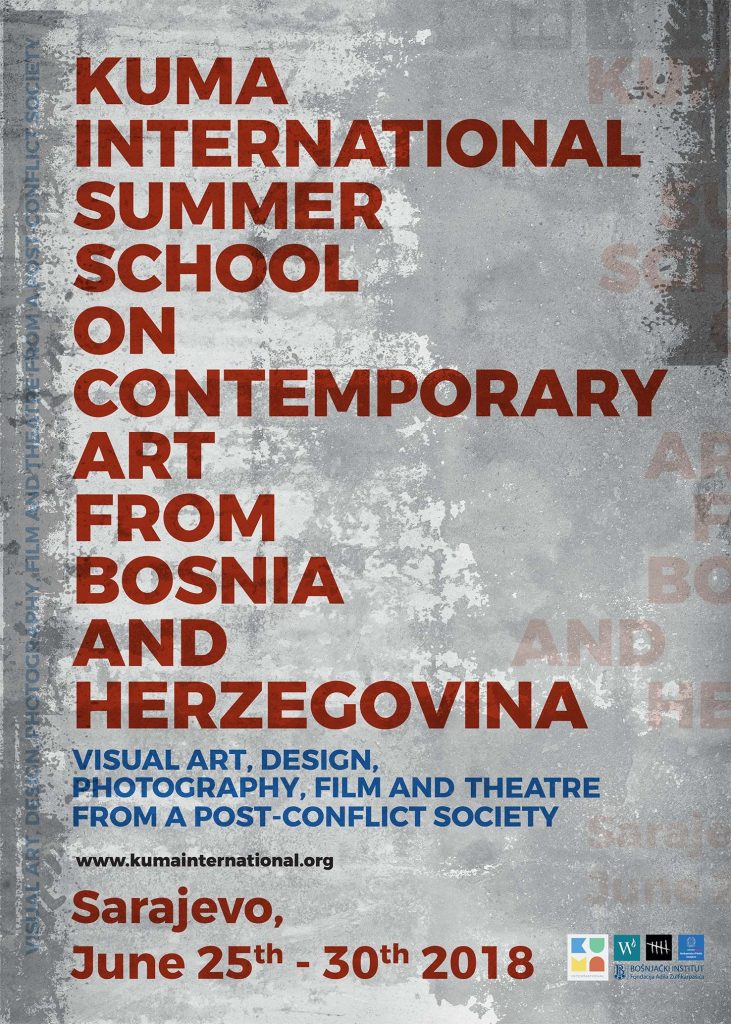Kuma International Summer School on Contemporary Art from Bosnia and Herzegovina
A project by Claudia Zini
Sarajevo, June 25th-30th 2018
Kuma International
Kuma International, with the patronage of the Italian Embassy in Bosnia-Herzegovina and in partnership with the Bosniak Institute – Adil Zulfikarpašić Foundation, the WARM Foundation and Brodac Gallery, presents a one-week intensive course on contemporary art from Bosnia and Herzegovina, focusing on visual art, design, photography, film and theatre from a post-conflict society. Participation is open to graduates and postgraduates from the relevant disciplines, as well as art historians, curators, artists and museum professionals, and all people interested in training and developing new skills while experiencing a new and exciting learning environment in Sarajevo, the vibrant capital of Bosnia and Herzegovina.
Kuma International Summer School
The first Kuma International Summer School focuses on the post-war artistic production from Bosnia and Herzegovina. Students will look at how artists from the region have been affected by the political turmoil of the 1990s and how they have processed the fall of Yugoslavia, the 1992-1995 war and its consequences through their art practices. Students will also have the unique chance to meet with local artists, explore the city’s museums and art galleries and visit artists’ studios. Addressing contemporary visual art produced in the context of conflict and trauma, Kuma’s first summer school and its local and international staff will provide a glimpse into the impact of war on local artists’ aesthetics and narrative. At the same time, the school will look at the phenomenon of a new generation of visual artists and cultural workers belonging to the Bosnian diaspora who have started to come back to their country of origin out of a need to reconnect with their homeland and elaborate their traumatic war experience through art.
Kuma International Summer School is the first international program entirely dedicated to the contemporary art scene of the Bosnian region. Twenty students will attend this year the summer school coming from thirteen different countries: Bosnia and Herzegovina, Italy, France, Slovenia, Germany, Poland, Greece, Spain, Portugal, The Netherlands, Norway, Denmark, and the United States.
Why study contemporary art production from Bosnia and Herzegovina?
Kuma International believes that studying the war and post-war Bosnian cultural production can offer valuable insights into the nature of conflicts. It also raises important questions such as: what can art contribute to our understanding of war and conflict? Can the production as well as the viewing of art inspire non-verbal reconciliation of past atrocities? Which role can artists have in the memorialization of the past? Will their work prevent further genocide and mass violence in the region and promote reconciliation?
School program
Scholars from Bihac University (BiH), International University of Sarajevo (IUS), the Courtauld Institute of Art (UK), UCL School of Slavonic and East European Studies (UK), Salem State University Center of Holocaust and Genocide Studies (USA) and RMIT University (Australia) will join the summer school, together with about fifteen visual artists, photographers and film-makers from Bosnia and Herzegovina and the Bosnian diaspora (Austria, United States and Canada).
Some of the topics that will be explored during the summer program are: Sarajevo in the 1980s and the last episode of the Yugoslav contemporary art scene, with the emergence of the Zvono collective in parallel with the Sarajevo’s notorious ‘New Primitives’ subcultural scene and alongside the practice of Jusuf Hadžifejzović. Art, design and theatre in Sarajevo under the siege, aesthetics of crisis in post-war Bosnia and Herzegovina, the art of remembering the past, reimagining the stories and images of the places of pain and (be)longing, exploring also different approaches of dealing with the past in the Balkans and the role of art as a powerful tool for (re)creating and fostering cross-cultural dialogue in the Balkans.
Three documentaries will be screened during Kuma International Summer School: “The Siege” (2016) by Le Monde war reporter Rémy Ourdan, “Nostalgia” (2017) by Ervin Tahirović, and ŠTO TE NEMA – Boston (2018) by Rialda Zukić. The short film SNOVI (2010) by Reshad Kulenović will also be presented.
Artist Aida Sehović will held the participatory workshop “Art for Justice: Creating Alternative Spaces through ŠTO TE NEMA public monument “ which uses ritual and politics to create a radical model for a truly public monument. Traditional Bosnian coffee will be made, served and shared on-site with the students of the Kuma International Summer School.
As one of the applicants wrote in their motivation letter, “Understanding the complexities of armed conflicts and their aftermath can be undertaken through a variety of disciplines and paths, all of which are remarkable and laudable. The arts, however, possess a uniqueness in this endeavour. The arts are always already about the human condition and will, therefore, portray (in this context) the human experience of war and peace. This, indeed, is something which cannot and should not be undervalued”.
Venue
The summer school will be hosted by Networks in Skenderpašina Street 1, Sarajevo 71000

